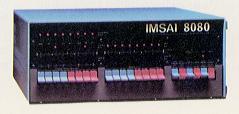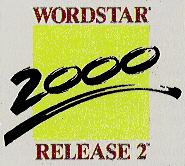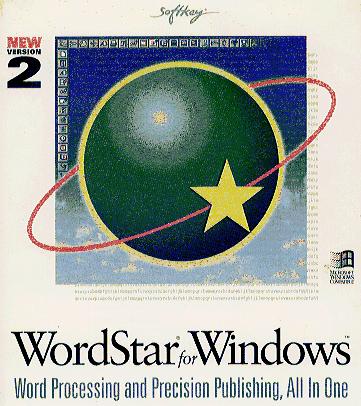The earliest microcomputers were really only of interest to electronic
tinkers and computer hobbyists. Their complexity and lack of useful
applications made them nearly worthless for any serious use by the
general public. Word Processing was one of the "killer"
applications that brought the microcomputer into the main stream.
The first commercial word processors were really dedicated
minicomputers connected to electric typewriters. Made by IBM,
Lanier, and Wang, these machines were completely proprietary.
The software resided in ROM and, at first, the only acceptable
letter quality printer was the IBM Selectric typewriter. Later,
daisy wheel printers made by Xerox (Diablo), NEC, and Qume were
made available. Such systems were expensive (10,000+ 1970 dollars),
but for many busy offices, they paid for themselves in a short time.
The first word processing program for microcomputers was The Electric Pencil
written by Michael Shayer. Originally it was only a text editor, but later
Shayer added formatting and printer features making it into a word processor.
Soon, Radio Shack released Scripsit for the TRS-80 while Apple Writter, Magic
Window, and Word Handler became available for the Apple II.
In 1978, word processors were fairly simple, performing basic functions like
word wrap and text scrolling. Then, along came WordStar and the written word
was changed forever.
IMSAI Manufacturing
 Soon after the introduction of the Altair 8800, Bill Millard started IMSAI
Manufacturing Corp. in San Leandro, CA. to develop a computer that was
compatible with the Altair, but overcame many of its short comings. The IMSAI
8080 was very much an Altair look alike, right down to the I/O plugin bus. It
did, however, offer front panel rocker switches, an active terminated bus
board, and a heftier power supply. This system became very popular with
commercial customers, finally outselling its protégé.
Soon after the introduction of the Altair 8800, Bill Millard started IMSAI
Manufacturing Corp. in San Leandro, CA. to develop a computer that was
compatible with the Altair, but overcame many of its short comings. The IMSAI
8080 was very much an Altair look alike, right down to the I/O plugin bus. It
did, however, offer front panel rocker switches, an active terminated bus
board, and a heftier power supply. This system became very popular with
commercial customers, finally outselling its protégé.
Seymour Rubenstein worked at IMSAI as a software developer. He envisioned a
time when software would propel the industry and wanted to be a part of it.
Rubenstein left IMSAI, to start Micropro International in San Rafael, CA,
taking programmer Rob Barnaby and Bill Lohse from sales with him. The first two
Micropro products were Supersort, a sorting program, and Wordmaster, a word
processor. Coded by Barnaby, both programs were released in September 1978
after only a few months in development.
One source indicates that Supersort and Wordmaster were actually written (by
Barnaby) at IMSAI and taken (Millard was not interested in marketing them) to
Micropro by Rubenstein.

Although Wordmaster was fairly popular it lacked a printing routine. Barnaby
immediately started coding WordStar - adding print routines and menu selected
formatting commands.
According to Rubenstein, Barnaby was the "mad genius
of assembly language coding". In four months he wrote 137,000 lines of
bulletproof code, the equivalent of 42 man years according to IBM's in-house
production benchmark. WordStar ran on the CP/M operating system, and with
Rubinstein and Lohse's marketing efforts, quickly dominated the field. It was
ported to every brand of CP/M computer on the market. When Adam Osborne came
out with his Osborne portable computer, he included a free suite of software
applications with each system. Others soon followed his lead and WordStar, the
included word processor, became the standard. Each computer maker provided the
user manuals and program media making this arrangement hugely profitable for
Micropro.
By the time version 3 was released, WordStar included context sensitive
on-line help, mail merge, and Correct-It, a stand-alone spell checker. Copy
protection had been dropped in version 2. WordStar basically invented the idea
of what you see is what you get (WYSIWYG), albeit character style. They
were also the first to use overlay files, which later evolved into DLLs
(Dynamic Link Libraries).
Early keyboards had no function keys or cursor movement keys, but they did have
a control key. The Control key, plus one or two character keys, was used to
move the cursor on the screen, format text, and provide all kinds of program
navigation.
When the IBM PC was released in 1981, WordStar was ported to DOS. Function and
cursor control key support was added, but it still retained its handy Control
key formatting.
Meanwhile, two of WordStar's top programmers, Barnaby and a later hire Peter
Mierau, left Micropro to form NewStar Software, Inc. where they produced a
WordStar work alike called NewWord. They improved upon the WordStar model and
competed successfully with it.
As the demand for word processing increased, large companies were stuck with
typing pools accustomed to using dedicated word processors. WordPerfect came
out with a system that ran on the PC, but used the familiar keystrokes of the
dedicated word processing machines.
On the PC platform WordStar met increased competition particularly from
WordPerfect with its easier to learn interface and unlimited, free technical
support. New users, and those coming from dedicated word processors, preferred
WordPerfect while users staying with or migrating from the CP/M world loved
their WordStar.
Microsoft, fast becoming rich from its sales of PC-DOS and MS-DOS, saw the
potential in application software and came out with its own word processing
program, Word. To get it into the hands of users quickly, Microsoft distributed
free Word disks with several popular computer magazines. Of course, the
full-featured program with documentation was then offered for sale.
The PC became popular in colleges, and while expensive commercial word
processors were out of reach for most students, a program called PC-Write was
sold as cheap shareware. This program used the familiar keystrokes of WordStar,
but produced ASCII output that could be converted for use by most other
programs and handled by all printers.
 Meanwhile, WordStar was falling behind. Since MicroPro realized they had no one
on staff who understood the WordStar code enough to do more than minimal
patches, they wrote an entirely new word processor called WordStar 2000. 2000
used entirely different keystroke commands alienating their WordStar installed
based, changed the file format, and was generally a very inefficiently written
program. It flopped miserably.
Meanwhile, WordStar was falling behind. Since MicroPro realized they had no one
on staff who understood the WordStar code enough to do more than minimal
patches, they wrote an entirely new word processor called WordStar 2000. 2000
used entirely different keystroke commands alienating their WordStar installed
based, changed the file format, and was generally a very inefficiently written
program. It flopped miserably.
To get back in the game, MicroPro bought NewWord, rehired the principals, and
groomed a new version of NewStar as WordStar 4.0. Peter Mierau, principal
programmer for WordStar 4.0, did the major redesign work through WordStar 5.0,
and then left again to form Roxxolid (pronounced "rock-solid")
Software.
Somewhere along in here, MicroPro reorganized as WordStar International
Corporation. After WordStar 7.0 was released, they realized they needed a
Windows based program and lacked the resources to write one themselves from
scratch. Porting the DOS version was out of the question; the effort of doing
that had nearly killed WordPerfect Corporation, a much bigger and richer
company, and resulted in a slow program that no one liked (the DOS folks stayed
with the DOS program and the Windows folks thought it looked too much like a
DOS program).
WordStar licensed the source code to a smallish desktop publishing program
called Legacy, from a company named NBI. WordStar Legacy was essentially that
code with some file conversion and keystrokes bolted on. A substantially
improved (internally) version was soon released as WordStar for Windows 1.0.
This all happened during the Windows 3.0 time frame. [This author never tried
Legacy, but WSWin 1.0 was so unstable that a simple two page letter could not
be written without a crash.]
WordStar for Windows 1.5 was the Windows 3.1 update; faster and more stable.
WordStar for Windows 2.0 was a nearly complete rewrite of the NBI code, and was
a quite capable small desktop publishing program with good text editing
capabilities.
Unfortunately, a few weeks before initial release, Softkey International bought
the company. The programmers finished what they could and Softkey released it
with the already printed manuals at a bargain price of $49. It really needed
one last grooming and a 2.1 bug fix release, but that never happened. The file
format was probably its biggest weakness; it led to bloated files,
slower-than-necessary performance, and potentially flaky memory management in
complicated files.

More recently, The Learning Company bought Softkey - and WordStar has faded
away like an old soldier.
All modern word processors owe their existence to WordStar - perhaps one of
the greatest single software efforts in the history of computing.

 Soon after the introduction of the Altair 8800, Bill Millard started IMSAI
Manufacturing Corp. in San Leandro, CA. to develop a computer that was
compatible with the Altair, but overcame many of its short comings. The IMSAI
8080 was very much an Altair look alike, right down to the I/O plugin bus. It
did, however, offer front panel rocker switches, an active terminated bus
board, and a heftier power supply. This system became very popular with
commercial customers, finally outselling its protégé.
Soon after the introduction of the Altair 8800, Bill Millard started IMSAI
Manufacturing Corp. in San Leandro, CA. to develop a computer that was
compatible with the Altair, but overcame many of its short comings. The IMSAI
8080 was very much an Altair look alike, right down to the I/O plugin bus. It
did, however, offer front panel rocker switches, an active terminated bus
board, and a heftier power supply. This system became very popular with
commercial customers, finally outselling its protégé.

 Meanwhile, WordStar was falling behind. Since MicroPro realized they had no one
on staff who understood the WordStar code enough to do more than minimal
patches, they wrote an entirely new word processor called WordStar 2000. 2000
used entirely different keystroke commands alienating their WordStar installed
based, changed the file format, and was generally a very inefficiently written
program. It flopped miserably.
Meanwhile, WordStar was falling behind. Since MicroPro realized they had no one
on staff who understood the WordStar code enough to do more than minimal
patches, they wrote an entirely new word processor called WordStar 2000. 2000
used entirely different keystroke commands alienating their WordStar installed
based, changed the file format, and was generally a very inefficiently written
program. It flopped miserably.
